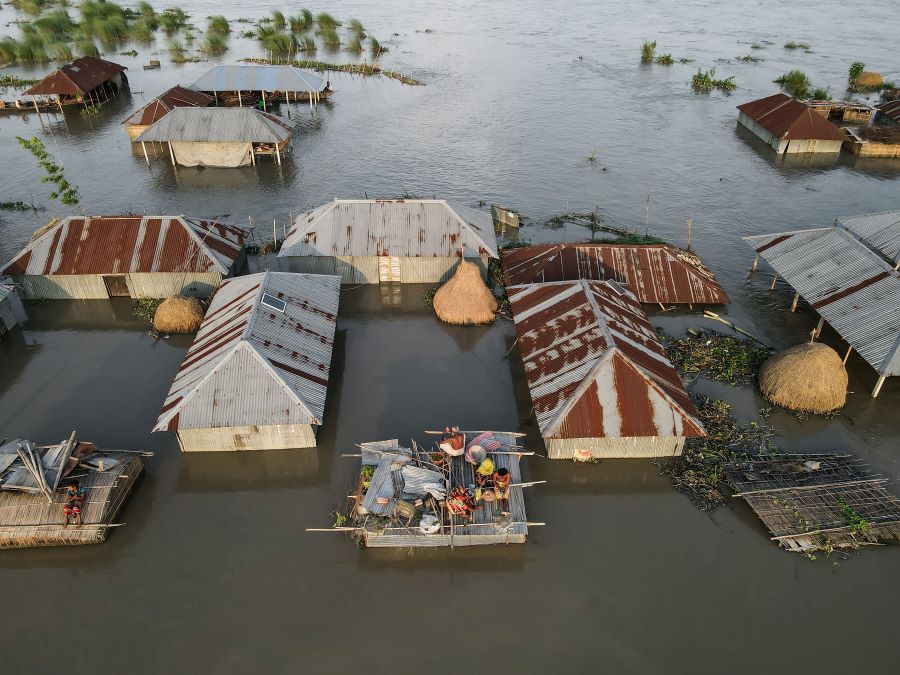Report on Climate Change Projections and Sustainable Development Goal Implications
1.0 Climate Projections and the Urgency for SDG 13 (Climate Action)
A new analysis by S&P Global indicates a high probability that global temperature increases will surpass the targets set by the Paris Agreement, directly challenging the achievement of SDG 13 (Climate Action). The report’s probabilistic model presents a critical outlook for global climate efforts.
- There is a 90% likelihood that the average global temperature will exceed the 1.5° Celsius target by 2040.
- There is a 50% likelihood that warming will reach 2.3° Celsius by 2040.
- The probability of remaining below the 1.5° Celsius threshold by 2040 is estimated at just 2.5%.
These projections signal a shift to a less ambitious pace of emissions reductions globally, necessitating an urgent strategic pivot towards adaptation and resilience as a core component of climate action.
2.0 The Global Adaptation and Resilience Deficit
Despite clear evidence of accelerating climate change, investment in adaptation and resilience remains critically insufficient to address the projected physical risks. This gap undermines progress across multiple Sustainable Development Goals, particularly those focused on poverty, economic growth, and sustainable communities.
2.1 Challenges to Adaptation Investment
Several factors contribute to the persistent gap in climate adaptation financing:
- The private sector often overlooks the broader societal benefits of adaptation, focusing instead on direct commercial viability.
- The implementation of adaptation and resilience infrastructure is frequently associated with high upfront costs.
- Significant uncertainties and data gaps in climate risk modelling deter investment and strategic planning.
2.2 Economic Impacts and Link to Development Goals
The failure to invest in resilience has severe economic consequences, directly impacting the stability required for sustainable development.
- SDG 8 (Decent Work and Economic Growth): Economic losses related to physical climate risks are escalating, reaching $328 billion in 2024, which threatens economic stability and sustainable growth.
- SDG 1 (No Poverty): The United Nations Environment Programme estimates an adaptation investment gap of approximately $210 billion annually by 2030 for developing economies alone, jeopardizing the livelihoods of the most vulnerable populations.
3.0 The Role of the Private Sector and SDG 17 (Partnerships for the Goals)
Analysis from the Zurich Climate Resilience Alliance highlights the limitations and potential of private sector finance in closing the adaptation gap, underscoring the importance of SDG 17 (Partnerships for the Goals).
- The private sector is not expected to provide the majority of adaptation funding needed by developing countries.
- With concerted effort, private sector contributions could increase from the current 3% to 15% or more, particularly in middle-income countries and sectors like agriculture and water management.
- A primary barrier is that many essential adaptation projects, such as coastal defenses, offer significant social and environmental benefits but are not commercially viable and do not generate direct income, thus failing to attract private investment.
4.0 Conclusion: A Strategic Imperative for Integrated Action
The findings mandate that adaptation can no longer be an afterthought but must be central to risk management and development strategies. Investing in targeted resilience measures is critical for safeguarding communities and economies.
- SDG 11 (Sustainable Cities and Communities): Adaptation is a lifeline for vulnerable communities, and without it, countries cannot build the resilience needed to make settlements safe and sustainable.
- SDG 9 (Industry, Innovation, and Infrastructure): Targeted investments in resilient infrastructure, such as flood defenses, advanced cooling systems, and rerouted logistics, are essential and can yield significant returns when aligned with realistic climate outcomes.
Achieving the Sustainable Development Goals is intrinsically linked to building a world resilient to a 2.3° Celsius temperature increase. This requires a collaborative effort, integrating public and private finance to protect vulnerable populations and ensure a sustainable future.
Analysis of SDGs, Targets, and Indicators
1. Which SDGs are addressed or connected to the issues highlighted in the article?
-
SDG 13: Climate Action
- The entire article is centered on climate change, specifically the failure to meet the Paris Agreement’s temperature goals and the urgent need for climate adaptation and resilience. It directly discusses rising global temperatures, emissions reductions, and the consequences of inaction, which are the core components of SDG 13.
-
SDG 11: Sustainable Cities and Communities
- The article mentions specific adaptation measures such as “flood defences” and “cooling systems” which are critical for making cities and human settlements resilient to the impacts of climate change. The discussion on protecting communities from losses directly relates to building sustainable and safe communities.
-
SDG 17: Partnerships for the Goals
- The article extensively discusses the financial gap in climate adaptation, particularly in developing countries. It highlights the roles and limitations of both the public and private sectors in providing this funding. This focus on mobilizing financial resources and the partnership between different sectors to achieve climate goals is central to SDG 17.
2. What specific targets under those SDGs can be identified based on the article’s content?
-
SDG 13: Climate Action
- Target 13.1: Strengthen resilience and adaptive capacity to climate-related hazards and natural disasters in all countries. The article’s main argument is that “climate adaptation and resilience needs remain largely unmet” and that “the world has not invested enough in climate change resilience,” directly addressing the lack of progress on this target.
- Target 13.a: Implement the commitment undertaken by developed-country parties… to a goal of mobilizing jointly $100 billion annually… to address the needs of developing countries. The article highlights a significant failure to meet this financial commitment by quoting the United Nations Environment Programme’s estimate of an “adaptation investments gap at about $210 billion yearly by 2030 for developing economies alone” and the Zurich Climate Resilience Alliance’s figure of a gap at “nearly $300 billion per year.”
-
SDG 11: Sustainable Cities and Communities
- Target 11.b: By 2020, substantially increase the number of cities and human settlements adopting and implementing integrated policies and plans towards… adaptation to climate change, resilience to disasters… The article points to a deficit in achieving this target by noting that adaptation measures like “flood defences, cooling systems, or logistics rerouting” are underfunded and not yet at the “core of risk management.”
-
SDG 17: Partnerships for the Goals
- Target 17.3: Mobilize additional financial resources for developing countries from multiple sources. The article directly discusses this by analyzing the role of the private sector, stating that its contribution to adaptation funding is currently only 3% but could potentially increase to 15% with “a concerted effort.” This underscores the challenge of mobilizing resources from diverse sources beyond public funds.
3. Are there any indicators mentioned or implied in the article that can be used to measure progress towards the identified targets?
-
Indicators for Climate Change and Resilience
- Average global temperature increase: The article uses this as a primary indicator of climate change, stating there is a “90% likelihood that, by 2040, the average global temperature will exceed the Paris Agreement’s goal of 1.5° Celsius” and a “50% likelihood of it exceeding 2.3 degrees Celsius.” This directly measures the scale of the climate challenge.
- Economic losses related to physical climate risks: The article provides a specific monetary value to quantify the impact of climate change, noting that these losses are “rising, reaching $328 billion in 2024 according to Swiss Re.” This can be used as an indicator to measure the effectiveness of resilience and adaptation measures.
-
Indicators for Climate Finance
- Annual adaptation investment gap for developing economies: The article quantifies this gap, citing figures of “$210 billion yearly by 2030” and “nearly $300 billion per year.” Tracking this gap is a direct measure of progress towards meeting the financial needs of developing countries (Target 13.a).
- Private sector contribution to adaptation finance: The article provides a clear indicator by stating that “private sector adaptation flows could increase from the current figure of 3% to 15% or more.” This metric can be used to measure the success of mobilizing financial resources from multiple sources (Target 17.3).
4. Summary Table of SDGs, Targets, and Indicators
| SDGs | Targets | Indicators (Mentioned or Implied in the Article) |
|---|---|---|
| SDG 13: Climate Action |
13.1: Strengthen resilience and adaptive capacity to climate-related hazards.
13.a: Mobilize climate finance for developing countries. |
– Average global temperature increase (projected to exceed 1.5°C and 2.3°C). – Economic losses from climate risks ($328 billion in 2024). – Annual adaptation investment gap ($210 billion – $300 billion per year). |
| SDG 11: Sustainable Cities and Communities | 11.b: Increase the number of cities implementing policies for inclusion, resource efficiency, and resilience to climate change. | – Level of investment in resilience measures such as flood defences and cooling systems (implied to be insufficient). |
| SDG 17: Partnerships for the Goals | 17.3: Mobilize additional financial resources for developing countries from multiple sources. | – Percentage of adaptation funding provided by the private sector (currently 3%, with potential to rise to 15%). |
Source: forbes.com







